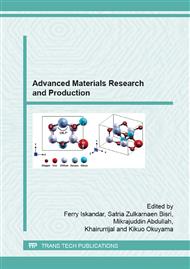p.120
p.124
p.128
p.133
p.141
p.145
p.149
p.154
p.158
Development of Emulsion Gels and Macroporous Hydrogels and their Applications to Metal Adsorption and Enzyme Reaction
Abstract:
Emulsion gels, that is, hydrogels containing randomly distributed oil microdroplets, and macroporous hydrogels with randomly distributed, non-interconnected, sphere-like macropores with several micrometers in diameter were prepared by the emulsion-gelation method [1]. This method involves the synthesis of hydrogels in an oil-in-water (O/W) emulsion by free radical copolymerization of a monomer with a cross-linker, followed by the washing (removal) of the dispersed oil as a pore template (porogen). The observations of oil droplets in an emulsion and internal structure of a macroporous hydrogel demonstrate that the oil droplets act as a pore-template. The pore size and porosity can be adjusted by varying the O/W volume ratios and surfactant amounts [2]. These gels are used as a bulk and have excellent diffusional permeability to a solute and solvent. The emulsion-gelation method can yield potentially intelligent gels in which the macropores function as spaces for reaction, separation and storage. Novel emulsion gel adsorbents, that is, polymeric hydrogels containing randomly distributed microdroplets of an organic extractant (an oil-soluble complexing agent), were developed for metal adsorption [3,4]. The emulsion gel containing an organophosphorus extractant and organosulfur extractant successfully adsorbed In (III) and Pd (II) ions, respectively. Novel macroporous polymeric hydrogels were developed to entrap and immobilize lipase as a model enzyme [5]. The lipase immobilized within the macroporous hydrogel successfully catalyzed the hydrolysis of triacetin in a model enzyme reaction without leakage of lipase or loss of activity during repeated use.
Info:
Periodical:
Pages:
141-144
Citation:
Online since:
July 2015
Authors:
Keywords:
Price:
Сopyright:
© 2015 Trans Tech Publications Ltd. All Rights Reserved
Share:
Citation:


